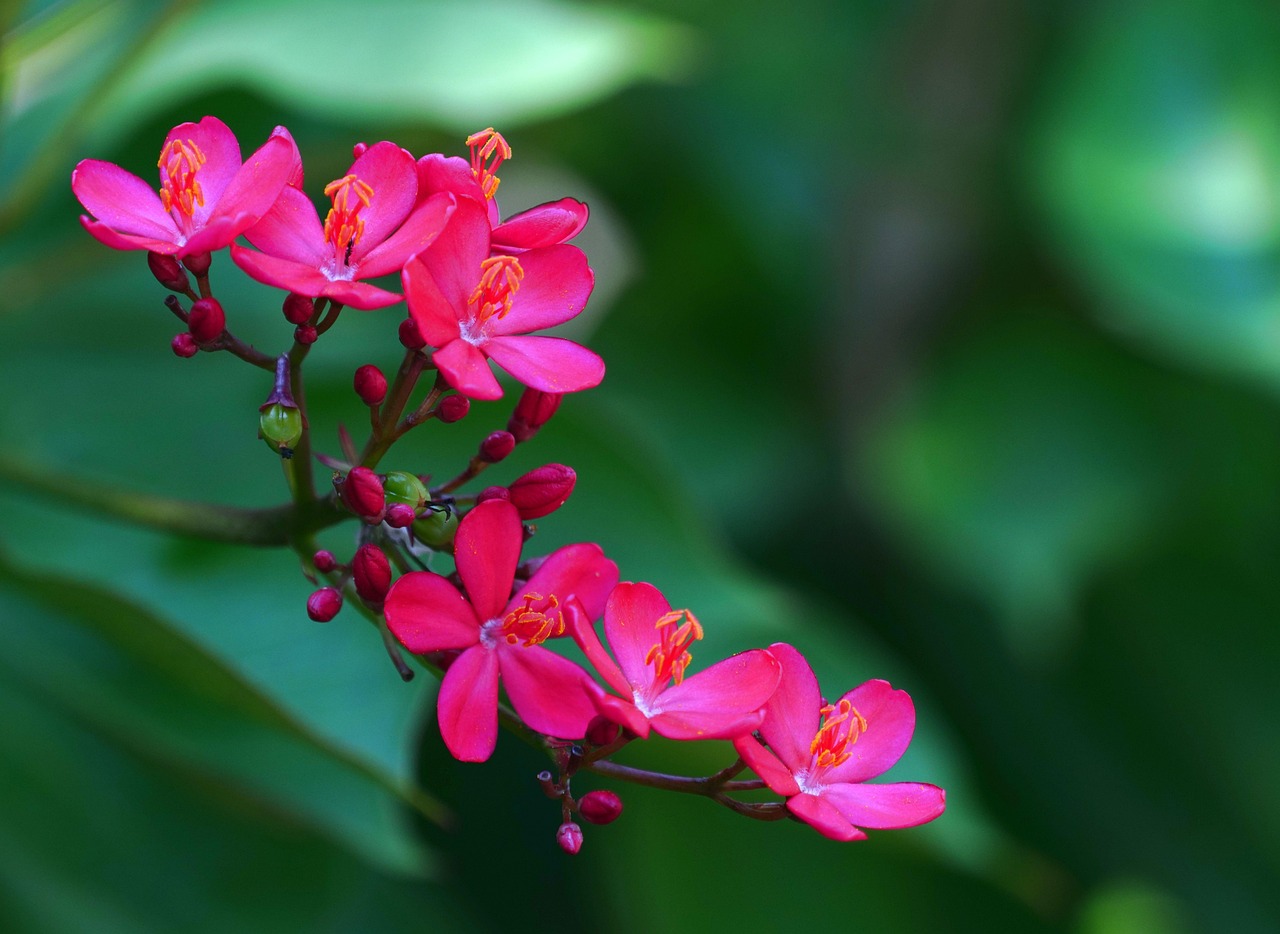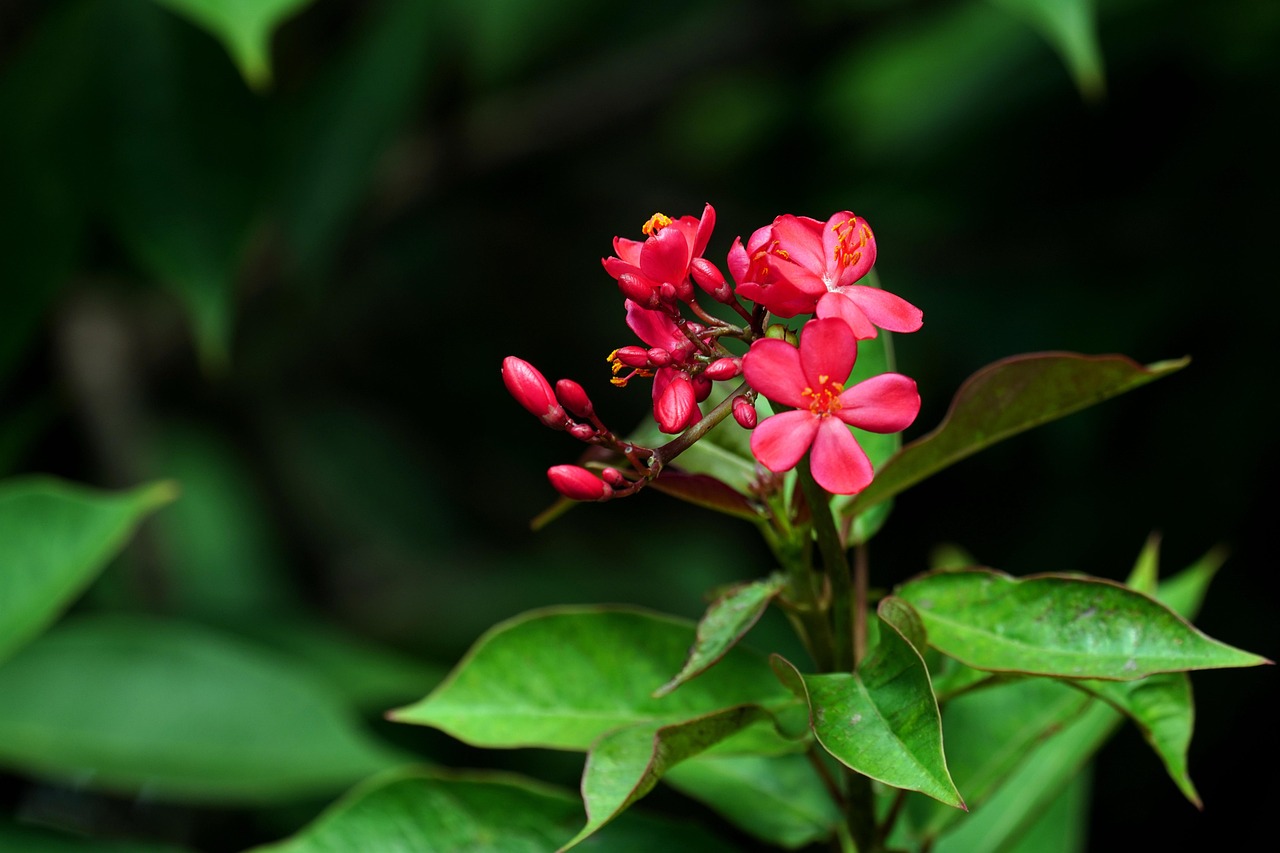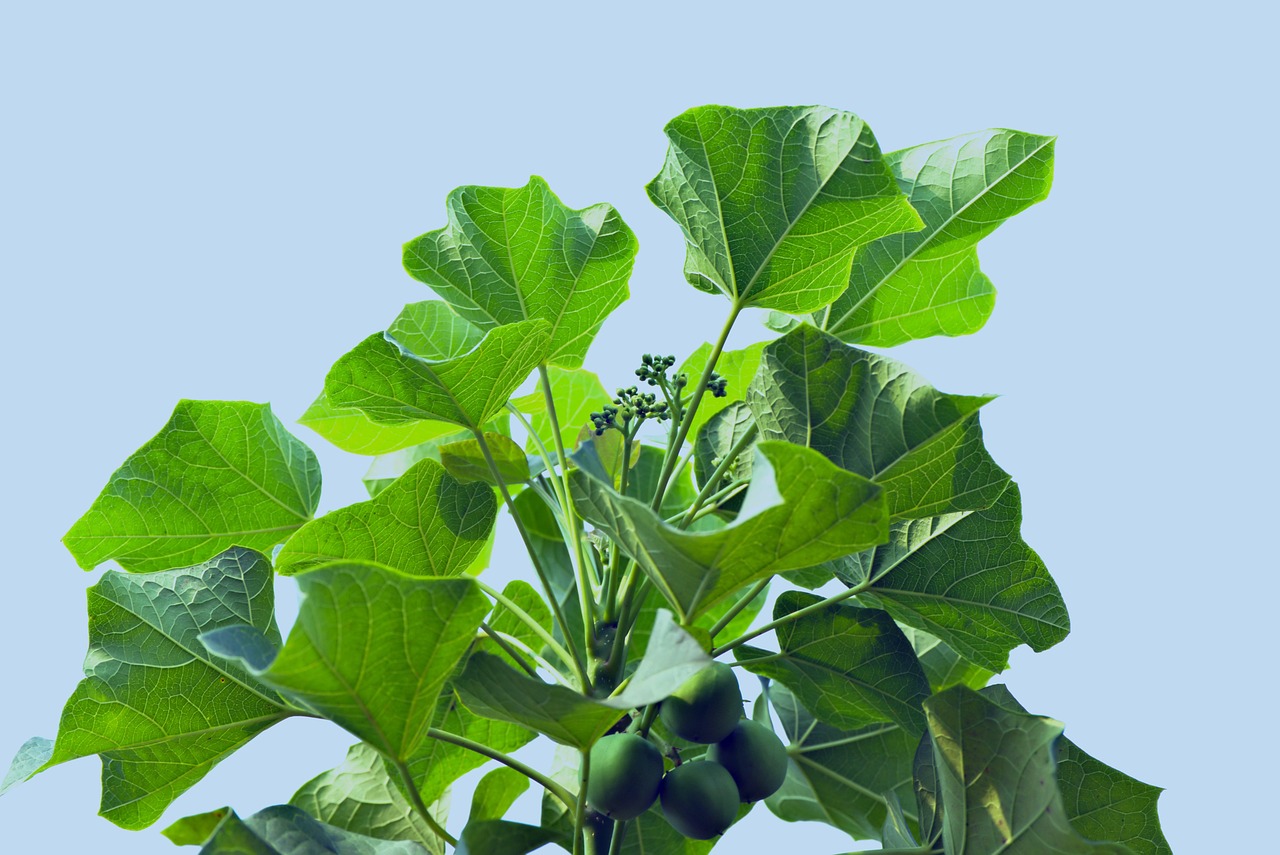The Jatropha tree has a moderate growth rate, typically reaching 3 to 5 feet in height within its first year. Under optimal conditions, it can grow up to 10 to 15 feet tall within five years, making it suitable for both biofuel production and landscaping applications.
The Jatropha tree, scientifically known as Jatropha curcas, is gaining popularity for its potential in biofuel production and as an ornamental landscaping plant. This tropical shrub is native to Central America but has adapted well to various climates around the world. Its seeds contain high oil content, making them a viable source for biodiesel production. The tree can thrive in arid and semi-arid regions, adding to its appeal as a sustainable crop.

In addition to its economic benefits, Jatropha trees offer ecological advantages. They can help prevent soil erosion, improve soil fertility, and create habitats for wildlife. Due to their ability to grow in poor soils, they can be planted in areas unsuitable for other crops, contributing to land reclamation efforts.
Growth Characteristics
The growth rate of Jatropha trees can vary based on several factors. These include soil quality, climate conditions, and maintenance practices. Typically, Jatropha trees have a fast initial growth phase but may slow down as they mature. Below are some key growth characteristics:
| Factor | Impact on Growth Rate |
|---|---|
| Soil Quality | Well-drained sandy or loamy soils promote faster growth. |
| Climate | Warm temperatures with adequate rainfall enhance growth rates. |
| Irrigation | Supplemental watering can improve growth in dry periods. |
| Fertilization | Proper nutrients can accelerate growth and oil production. |
| Pest Control | Managing pests ensures healthy growth and higher yields. |
Typically, Jatropha trees take about three years to start producing seeds. However, with optimal care and conditions, the yields can be significantly improved. Once established, these trees can live for several decades, providing a long-term source of biofuel and landscape benefits.

The Jatropha tree is often planted in hedgerows or as boundary markers. Its dense foliage provides visual privacy and can also serve as windbreaks in agricultural settings. In landscaping, it is appreciated for its attractive flowers and ability to tolerate drought conditions. The tree produces yellow or red flowers that bloom throughout the year, attracting pollinators like bees and butterflies.
For those interested in growing Jatropha trees for biofuel or landscaping purposes, it is essential to consider the following cultivation tips:
- Select a sunny location with well-draining soil.
- Space trees adequately to allow for air circulation and sunlight exposure.
- Regularly prune to maintain desired shape and health.
- Monitor for pests and diseases that can affect growth.
- Implement sustainable agricultural practices to enhance soil health.
The adaptability of the Jatropha tree makes it an excellent choice for various environments. From its utility in biofuel production to its aesthetic appeal in landscaping, the tree’s growth rate plays a crucial role in determining its success in different applications. Understanding the optimal conditions for growth can maximize both its ecological and economic benefits.

As this versatile plant continues to gain attention, ongoing research into its growth patterns and oil production potential will further illuminate its role in sustainable agriculture and renewable energy sources.
Jatropha Tree Cultivation Practices
Successful cultivation of the Jatropha tree requires understanding its specific needs and characteristics. By implementing effective cultivation practices, growers can optimize both the growth rate and oil yield of this valuable resource. Below are several key practices that can significantly influence Jatropha tree health and productivity.
Soil Preparation
Before planting Jatropha trees, proper soil preparation is crucial. This involves several steps:
- Soil Testing: Conduct soil tests to determine nutrient levels and pH balance.
- Amendments: Based on test results, add organic matter or fertilizers to improve soil structure and fertility.
- Tillage: Turn the soil to aerate it, allowing roots to penetrate easily.
- Drainage: Ensure good drainage to prevent waterlogging, which can harm the roots.
Planting Techniques
The method of planting can impact the establishment and growth of Jatropha trees. Here are some recommended planting techniques:

- Spacing: Space trees about 6 to 10 feet apart to allow for adequate sunlight and air circulation.
- Pit Preparation: Dig holes that are at least twice the size of the root ball to facilitate root expansion.
- Planting Depth: Ensure that plants are placed at the same depth they were growing in their nursery containers.
- Watering: Water the newly planted trees thoroughly to help them settle into the soil.
Irrigation Practices
Irrigation plays a vital role in the growth of Jatropha trees, particularly in dry regions. Here are some effective irrigation strategies:
- Drip Irrigation: This method delivers water directly to the root zone, minimizing evaporation and runoff.
- Rainwater Harvesting: Collecting rainwater for irrigation can be an effective and sustainable approach.
- Scheduling: Water plants during dry spells, particularly during the first few years of growth.
- Moisture Monitoring: Use soil moisture sensors to optimize watering schedules and prevent over-irrigation.
Pest and Disease Management
Like any crop, Jatropha trees are susceptible to pests and diseases that can hinder growth. Implementing an effective management plan is essential for maintaining healthy plants. Common pests include aphids, whiteflies, and caterpillars. Here are some preventive measures:
- Cultural Practices: Rotate crops and maintain clean fields to reduce pest populations.
- Natural Predators: Encourage beneficial insects that prey on pests, such as ladybugs and lacewings.
- Pesticide Use: If necessary, use organic pesticides that are less harmful to beneficial insects.
- Monitoring: Regularly inspect plants for signs of infestations or disease symptoms.
Disease Prevention
Diseases such as root rot and leaf spot can impact Jatropha trees. To prevent these issues, consider the following:
- Proper Spacing: Ensure adequate spacing between plants to promote airflow.
- Water Management: Avoid over-watering and ensure proper drainage to reduce fungal infections.
- Healthy Seedlings: Source high-quality seeds or seedlings from reputable nurseries to minimize disease risks.
Nutrient Management
Nutrient availability is critical for Jatropha tree growth and oil production. Regular monitoring and appropriate fertilization can enhance yields. Key nutrients include nitrogen, phosphorus, and potassium. Here are some nutrient management strategies:
| Nutrient | Role in Growth | Recommended Sources |
|---|---|---|
| Nitrogen | Promotes vegetative growth and leaf development. | Urea, compost, or legume cover crops. |
| Phosphorus | Supports root development and flowering. | Bone meal, rock phosphate. |
| Potassium | Aids in overall plant health and oil accumulation in seeds. | Potasium sulfate, wood ash. |
Applying fertilizers based on soil test results can optimize nutrient uptake by Jatropha trees. By fostering a healthy growing environment, cultivators can ensure robust growth rates and higher oil yields from their Jatropha plants.
Environmental Benefits of Jatropha Trees
The Jatropha tree offers numerous environmental benefits that make it an attractive option for both biofuel production and landscaping. Its ability to thrive in poor soil conditions and its drought-resistant nature contribute to its sustainability. Understanding these environmental advantages can help promote the cultivation of Jatropha trees in various settings.
Soil Erosion Prevention
One of the primary benefits of planting Jatropha trees is their role in preventing soil erosion. The extensive root system of the tree helps stabilize the soil, reducing runoff and protecting against the loss of topsoil. Key points regarding soil erosion prevention include:
- Root Structure: Jatropha trees develop deep and wide root systems that anchor the soil.
- Ground Cover: The dense foliage provides ground cover, minimizing soil exposure to wind and rain.
- Contour Planting: Planting Jatropha on slopes can help create natural barriers against erosion.
Improving Soil Fertility
Jatropha trees contribute to soil fertility through several mechanisms:
- Organic Matter: As leaves fall and decompose, they enrich the soil with organic matter.
- Nitrogen Fixation: While Jatropha itself does not fix nitrogen, it can be planted alongside leguminous plants that do, enhancing overall soil nutrients.
- Crop Rotation: Including Jatropha in crop rotation systems can improve soil health by disrupting pest cycles and replenishing nutrients.
Biodiversity Support
Jatropha trees can serve as a habitat for various wildlife species. Their flowers attract pollinators such as bees and butterflies, while the tree itself provides shelter for birds and small mammals. The cultivation of Jatropha can support biodiversity in several ways:
- Pollinator Attraction: The nectar-rich flowers are a food source for pollinators, promoting healthy ecosystems.
- Habitat Creation: The tree’s structure provides nesting sites for birds and habitats for insects.
- Diverse Plantings: Planting Jatropha alongside other native vegetation can enhance biodiversity and ecological resilience.
Climate Change Mitigation
Growing Jatropha trees can also play a role in mitigating climate change. Some of the key contributions include:
- Carbon Sequestration: Jatropha trees absorb carbon dioxide from the atmosphere, helping to reduce greenhouse gases.
- Renewable Energy Source: The oil produced from Jatropha seeds can be converted into biodiesel, providing a sustainable alternative to fossil fuels.
- Reduced Dependence on Conventional Fuels: Cultivating Jatropha as a biofuel source can decrease reliance on non-renewable energy sources.
Economic Benefits of Jatropha Cultivation
The economic potential of Jatropha trees extends beyond biofuel production. Cultivating these trees can provide significant financial advantages for farmers and investors alike. Below are some key economic benefits:
Job Creation
The cultivation and processing of Jatropha can create jobs in rural areas. These jobs range from planting and maintenance to harvesting and oil extraction. Some important aspects include:
- Agricultural Employment: Local farmers can engage in Jatropha cultivation as an additional income source.
- Processing Facilities: Establishing facilities for oil extraction can provide job opportunities in manufacturing and logistics.
- Research and Development: Ongoing research into Jatropha cultivation may lead to new job opportunities in agricultural science.
Income Generation
The sale of Jatropha seeds and oil can provide substantial income for growers. The potential revenue streams include:
- Biodiesel Production: Oil extracted from Jatropha seeds is used to produce biodiesel, which is in growing demand.
- By-Products: The residual cake after oil extraction can be used as animal feed or organic fertilizer, adding further value.
- Carbon Credits: Farmers may be eligible for carbon credits through sustainable practices, providing additional financial incentives.
Cultural and Aesthetic Value
Apart from its practical applications, the Jatropha tree holds cultural significance in many regions. Its aesthetic appeal can enhance landscapes in various settings. Some points to consider include:
- Cultural Significance: In some cultures, Jatropha trees are valued for their medicinal properties and traditional uses.
- Aesthetic Appeal: The vibrant flowers and lush green foliage make Jatropha an attractive addition to gardens and public spaces.
- Drought Tolerance: Its ability to thrive in arid conditions makes it a suitable choice for landscaping in water-scarce areas.
The multifaceted benefits of cultivating Jatropha trees emphasize their importance not only for biofuel production but also for environmental sustainability, economic growth, and cultural enrichment. As interest in renewable energy sources continues to rise, the potential for Jatropha cultivation will likely expand further.
Future Prospects for Jatropha Cultivation
The future prospects for Jatropha cultivation appear promising, particularly as the global demand for renewable energy sources continues to grow. As technology advances, there are several key areas for potential development and improvement in Jatropha cultivation:
Advancements in Breeding Techniques
Improving the genetic traits of Jatropha trees can lead to better yields and increased oil content. Some potential advancements include:
- Hybrid Varieties: Developing hybrid Jatropha varieties may enhance resistance to pests and diseases, as well as improve growth rates.
- Genetic Engineering: Utilizing genetic engineering techniques could help produce trees with higher oil content or better drought tolerance.
- Selection of High-Yielding Varieties: Identifying and cultivating high-yielding Jatropha varieties can maximize benefits for growers.
Integration with Agroforestry Systems
Integrating Jatropha cultivation into agroforestry systems can enhance ecological sustainability and economic returns. Possible strategies include:
- Companion Planting: Growing Jatropha alongside other crops can create beneficial interactions, improving overall productivity.
- Shade Provision: Using Jatropha trees to provide shade for other crops can enhance microclimate conditions and reduce water stress.
- Livestock Integration: Allowing livestock to graze among Jatropha trees can minimize land competition and contribute to nutrient cycling.
Market Development and Policy Support
The expansion of the Jatropha industry will also depend on market development and supportive policies. Key considerations include:
- Consumer Awareness: Educating consumers about the benefits of biodiesel derived from Jatropha can help increase market demand.
- Government Incentives: Policies that provide financial incentives for sustainable biofuel production could encourage farmers to cultivate Jatropha.
- Investment in Infrastructure: Developing infrastructure for processing and distribution of Jatropha oil can facilitate market access for growers.
Challenges Ahead
Despite its many advantages, there are challenges associated with Jatropha cultivation that must be addressed. These challenges include:
- Pest and Disease Management: Ongoing monitoring and management of pests and diseases are crucial for maintaining healthy crops.
- Market Volatility: Fluctuations in the global biofuel market can affect the profitability of Jatropha cultivation.
- Resource Competition: As farmland becomes increasingly scarce, competition for land with food crops may pose challenges to Jatropha growers.
Conclusion
The Jatropha tree presents a unique opportunity for sustainable agriculture, biofuel production, and environmental conservation. Its moderate growth rate, ability to thrive in challenging conditions, and multiple uses make it an appealing choice for farmers and landscapers alike. The environmental benefits, including soil stabilization, increased biodiversity, and climate change mitigation, further highlight its importance in modern agriculture.
As advancements in breeding, agroforestry integration, and market development continue, the potential for Jatropha cultivation is likely to expand. However, addressing challenges such as pest management and market volatility will be essential for realizing its full potential. By fostering a supportive environment for Jatropha growers and promoting sustainable practices, we can harness the benefits of this remarkable tree for generations to come.
In summary, the multifaceted advantages of Jatropha cultivation offer a pathway towards a more sustainable future, combining economic growth with ecological resilience. As interest in renewable energy sources continues to grow, the role of Jatropha trees in biofuel production and landscaping will likely become increasingly significant.
